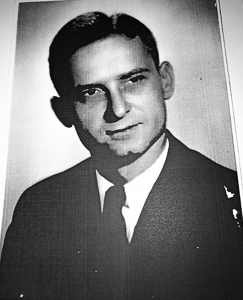As his body plummeted towards the Normandy landscape at 250 feet per second, Sgt. Hilliard was likely praying to God that his chute would open. He had been trained to clear the plane before pulling the cord. Sgt. Hilliard saw for only an instant that several of his crew mates managed to jump out of the damaged aircraft before it began its downward spiral and broke in two. Glancing up, he figured enough time had gone by to clear the damaged bomber. He pulled the cord and felt a rush of excitement and relief when the chute opened and caught the wind to slow down his descent. Those feelings were short-lived. Now he realized that he was at risk of being shot by the Luftwaffe attack fighters such as the Messerschmitt Me-109s and the Fw-190s or killed by the German’s anti-aircraft guns’ flak which had crippled his aircraft and worst of all, he had absolutely no control over the situation.

This is the story and fate of the top turret gunner, Hilton G. Hilliard (1920−1985), and the crew on the B-17F heavy bomber which was shot down over France on the evening of 29 May 1943. Read More Rendezvous With The Gestapo
